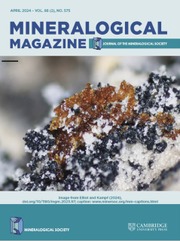Crossref Citations
This article has been cited by the following publications. This list is generated based on data provided by
Crossref.
Lutz, H. D.
Schneider, G.
and
Kliche, G.
1983.
Chalcides and pnictides of group VIII transition metals: Far-infrared spectroscopic studies on compounds MX 2, MXY, and MY 2 with pyrite, marcasite, and arsenopyrite structure.
Physics and Chemistry of Minerals,
Vol. 9,
Issue. 3-4,
p.
109.
Shapter, J.G
Brooker, M.H
and
Skinner, W.M
2000.
Observation of the oxidation of galena using Raman spectroscopy.
International Journal of Mineral Processing,
Vol. 60,
Issue. 3-4,
p.
199.
Naumov, Panče
Makreski, Petre
and
Jovanovski, Gligor
2007.
Direct Atomic Scale Observation of Linkage Isomerization of As4S4 Clusters during the Photoinduced Transition of Realgar to Pararealgar.
Inorganic Chemistry,
Vol. 46,
Issue. 25,
p.
10624.
Brusentsova, T.
Peale, R. E.
Maukonen, D.
Figueiredo, P.
Harlow, G. E.
Ebel, D. S.
Nissinboim, A.
Sherman, K.
and
Lisse, C. M.
2012.
Laboratory far-infrared spectroscopy of terrestrial sulphides to support analysis of cosmic dust spectra.
Monthly Notices of the Royal Astronomical Society,
Vol. 420,
Issue. 3,
p.
2569.
Avril, Caroline
Malavergne, Valérie
Caracas, Razvan
Zanda, Brigitte
Reynard, Bruno
Charon, Emeline
Bobocioiu, Ema
Brunet, Fabrice
Borensztajn, Stephan
Pont, Sylvain
Tarrida, Martine
and
Guyot, François
2013.
Raman spectroscopic properties and Raman identification of CaS‐MgS‐MnS‐FeS‐Cr2FeS4 sulfides in meteorites and reduced sulfur‐rich systems.
Meteoritics & Planetary Science,
Vol. 48,
Issue. 8,
p.
1415.
Orlova, A. Yu.
Gainov, R. R.
Dooglav, A. V.
and
Pen’kov, I. N.
2013.
Electronic structure and indirect spin-spin interactions in bournonite (CuPbSbS3) according to antimony nuclear quadrupole resonance.
JETP Letters,
Vol. 97,
Issue. 7,
p.
413.
Campos, Marcelo M Vallette
and
Aguayo, Tomás Alvarado
2015.
Vibrational spectroscopy for the study of Chilean cultural heritage.
Heritage Science,
Vol. 3,
Issue. 1,
Chandra, Usha
Sharma, Pooja
and
Parthasarathy, G.
2016.
High-pressure studies on nanocrystalline borderline Co1–xFexS2 (x = 0.4 and 0.5) using Mössbauer spectroscopic and electrical resistivity techniques up to 8 GPa.
Phase Transitions,
Vol. 89,
Issue. 12,
p.
1165.
Gerasimova, Y. V.
Oreshonkov, A. S.
Romanova, O. B.
Ivanenko, A. A.
and
Krylov, A. S.
2017.
Raman and infrared characterization of gadolinium-doped manganese sulfide.
Spectroscopy Letters,
Vol. 50,
Issue. 1,
p.
55.
Baláž, Peter
Baláž, Matej
Shpotyuk, Oleh
Demchenko, Pavlo
Vlček, Miroslav
Shopska, Maya
Briančin, Jaroslav
Bujňáková, Zdenka
Shpotyuk, Yaroslav
Selepová, Barbora
and
Balážová, Ľudmila
2017.
Properties of arsenic sulphide (β-As4S4) modified by mechanical activation.
Journal of Materials Science,
Vol. 52,
Issue. 3,
p.
1747.
Hao, Zhao
Bechtel, Hans A.
Kneafsey, Timothy
Gilbert, Benjamin
and
Nico, Peter S.
2018.
Cross-Scale Molecular Analysis of Chemical Heterogeneity in Shale Rocks.
Scientific Reports,
Vol. 8,
Issue. 1,
Bhattacharyya, Amrita
Schmidt, Michael P.
Stavitski, Eli
and
Martínez, Carmen Enid
2018.
Iron speciation in peats: Chemical and spectroscopic evidence for the co-occurrence of ferric and ferrous iron in organic complexes and mineral precipitates.
Organic Geochemistry,
Vol. 115,
Issue. ,
p.
124.
Díaz, E.
Voisin, L.
Kracht, W.
and
Montenegro, V.
2018.
Using advanced mineral characterisation techniques to estimate grinding media consumption at laboratory scale.
Minerals Engineering,
Vol. 121,
Issue. ,
p.
180.
Jovanovski, Gligor
and
Makreski, Petre
2020.
Intriguing minerals: photoinduced solid-state transition of realgar to pararealgar—direct atomic scale observation and visualization.
ChemTexts,
Vol. 6,
Issue. 1,
Švadlena, Jan
Prošek, Tomáš
Strachotová, Kristýna Charlotte
and
Kouřil, Milan
2020.
Chemical Removal of Lead Corrosion Products.
Materials,
Vol. 13,
Issue. 24,
p.
5672.
Hubbard, Kevin M.
Haberle, Christopher W.
Elkins‐Tanton, Linda T.
Christensen, Philip R.
and
Semken, Steven
2023.
Thermal‐Infrared Emission Spectroscopy of Graybody Minerals (Sulfide): Implications for Extraterrestrial Exploration for Magmatic Ore Deposits.
Earth and Space Science,
Vol. 10,
Issue. 2,




